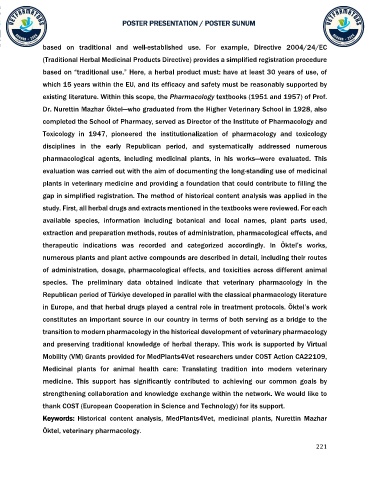Page 224 - congress
P. 224
POSTER PRESENTATION / POSTER SUNUM
based on traditional and well-established use. For example, Directive 2004/24/EC
(Traditional Herbal Medicinal Products Directive) provides a simplified registration procedure
based on “traditional use.” Here, a herbal product must: have at least 30 years of use, of
which 15 years within the EU, and its efficacy and safety must be reasonably supported by
existing literature. Within this scope, the Pharmacology textbooks (1951 and 1957) of Prof.
Dr. Nurettin Mazhar Öktel—who graduated from the Higher Veterinary School in 1928, also
completed the School of Pharmacy, served as Director of the Institute of Pharmacology and
Toxicology in 1947, pioneered the institutionalization of pharmacology and toxicology
disciplines in the early Republican period, and systematically addressed numerous
pharmacological agents, including medicinal plants, in his works—were evaluated. This
evaluation was carried out with the aim of documenting the long-standing use of medicinal
plants in veterinary medicine and providing a foundation that could contribute to filling the
gap in simplified registration. The method of historical content analysis was applied in the
study. First, all herbal drugs and extracts mentioned in the textbooks were reviewed. For each
available species, information including botanical and local names, plant parts used,
extraction and preparation methods, routes of administration, pharmacological effects, and
therapeutic indications was recorded and categorized accordingly. In Öktel’s works,
numerous plants and plant active compounds are described in detail, including their routes
of administration, dosage, pharmacological effects, and toxicities across different animal
species. The preliminary data obtained indicate that veterinary pharmacology in the
Republican period of Türkiye developed in parallel with the classical pharmacology literature
in Europe, and that herbal drugs played a central role in treatment protocols. Öktel’s work
constitutes an important source in our country in terms of both serving as a bridge to the
transition to modern pharmacology in the historical development of veterinary pharmacology
and preserving traditional knowledge of herbal therapy. This work is supported by Virtual
Mobility (VM) Grants provided for MedPlants4Vet researchers under COST Action CA22109,
Medicinal plants for animal health care: Translating tradition into modern veterinary
medicine. This support has significantly contributed to achieving our common goals by
strengthening collaboration and knowledge exchange within the network. We would like to
thank COST (European Cooperation in Science and Technology) for its support.
Keywords: Historical content analysis, MedPlants4Vet, medicinal plants, Nurettin Mazhar
Öktel, veterinary pharmacology.
221

